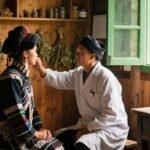English name:
Spleen Warming Decoction,Warm the Spleen Decoction
Chinese appellation:
温脾汤
Pinyin:
Wen Pi Tang
Author:
Sun Simiao
Source:
Beiji Qianjin Yaofang (Emergency Prescriptions Worth a Thousand Gold Pieces)
Ingredients (Decoction)
Rhubarb (Da Huang) 15 g
Angelica Root (Dang Gui) 9 g
Dried Ginger (Gan Jiang) 9 g
Prepared Aconite (Fu Zi) 6 g
Ginseng (Ren Shen) 6 g
Mirabilite (Mang Xiao) 6 g
Licorice (Gan Cao) 6 g
Usage
Decoct in water; take three times daily.

Indications & Actions
Primary Function
Wen Pi Tang warms and strengthens the spleen’s yang while purging cold accumulations. It is indicated for constipation and abdominal pain caused by insufficient spleen yang and retained cold in the intestines. By combining a gentle laxative effect with internal warming, it resolves “cold‑type” constipation in patients who exhibit both deficiency and accumulation.
Typical Symptoms
Constipation with cramping pain around the navel, coming and going in waves
Cold sensations in the limbs, white tongue coating, no thirst, deep and slow string‑like pulse
Modifications
If abdominal distension is prominent: add Magnolia bark (Hou Po) and Costus root (Mu Xiang) to move qi and relieve pain.
If cold pain is severe: add Cinnamon bark (Rou Gui) and Evodia fruit (Wu Zhu Yu) to enhance the warming and dispersing of cold.
Pathogenesis & Rationale
When spleen yang is weak and internal cold accumulates, the intestines become blocked by cold stagnation. Treatment must both expel the cold accumulation and reinforce spleen yang. A purely laxative remedy would further damage yang; pure warming would leave cold stagnation unresolved. Wen Pi Tang unites both approaches to address root and branch.
Formula Analysis
Chief Pair: Prepared Aconite and Rhubarb. Aconite strongly warms the center and dispels cold; Rhubarb purges cold accumulation.
Assistant Herbs: Mirabilite softens stool to enhance Rhubarb’s effect; Dried Ginger supports Aconite’s warming of spleen yang.
Protective Herbs: Ginseng and Angelica tonify qi and blood to safeguard against excessive purging; Licorice harmonizes and moderates the overall formula.
Key Commentary (from Tangtou Gejue Xiangjie)
“Wen Pi Tang is essentially Si Ni Tang (Gan Jiang, Fu Zi, Gan Cao) supplemented with Ginseng, Angelica, Rhubarb, and Mirabilite. Si Ni Tang’s warm‑tonifying nature counteracts the bitter cold of Rhubarb and Mirabilite, allowing the formula to drive out cold accumulation while supporting spleen yang. If one faces heat accumulation or fluid‑injury constipation, one should use a cold purgative instead—this is not the right formula for that pattern.”
— Wang Ang, Tangtou Gejue, China TCM Publishing, 2007
Major References
1.Beiji Qianjin Yaofang, Vol. 15: “Wen Pi Tang: Rhubarb 12 g, Prepared Aconite 9 g, Dried Ginger 6 g, Ginseng 6 g, Licorice 6 g. Main action: warms and tonifies spleen yang; purges heat accumulation.”
https://ctext.org/beiji-qianjin-yaofang/shi-wu
2,“Study on Processing Technique of Wen Pi Tang by HPLC,” Tianjin Journal of Chinese Materia Medica, 2015, Vol. 23 Issue 4.
http://www.tjzyy.com/CN/abstract/abstract4219.shtml
3,Patent CN1232268C “Preparation Method for Wen Pi Tang”
http://www.pss-system.gov.cn/…/CN1232268C
4,Xue Xiaoyan. Clinical Research on Modified Wen Pi Tang for Sepsis with Acute GI Injury. Thesis, Wanfang, 2019.
http://d.wanfangdata.com.cn/Thesis/YX2019000001
5,Huang Yuqin. Safety and Efficacy of Flavored Wen Pi Tang for Chronic Constipation in Elderly Care Residents. Taiwan Theses, 2015.
https://ndltd.ncl.edu.tw/…/Y2015000001
6,Wang Li et al. China Prescription Drugs, 8th Ed., 2023: Entry on Wen Pi Tang.
http://www.pharmnet.com.cn/Prescription/Entry/WenPiTang
7,Zhu Liangchun & Wang Qun. Tangtou Gejue Xiangjie, People’s Medical, 2012, p. 112.
http://www.pmph.com.cn/book/book_120.html
8,“Wen Pi Tang,” Chinese Wikipedia.
https://zh.wikipedia.org/wiki/温脾汤
9.Anti‑inflammatory Actions in Macrophages
Park YK, et al. Wen‑Pi‑Tang‑Hab‑Wu‑Ling‑San Extract Inhibits LPS‑Induced Production of NO and Proinflammatory Cytokines in RAW264.7 Cells.
Demonstrated that WHW strongly reduces iNOS, TNF‑α, IL‑1β and IL‑6 expression in LPS‑stimulated macrophages, confirming potent anti‑inflammatory effects PubMed.
10,Protection Against Diabetic Nephropathy
Kim JH, et al. Attenuating Effects of Wen‑Pi‑Tang Treatment in Rats with Diabetic Nephropathy.
Showed that Wen Pi Tang significantly reduced glomerular sclerosis, mesangial expansion and oxidative stress markers in streptozotocin‑diabetic rats, suggesting renal protective benefits PubMed.
11,Drug‑Herb Interaction via CYP450 Inhibition
Lee HJ, et al. In Vitro Inhibitory Effects of Wen‑Pi‑Tang‑Hab‑Wu‑Ling‑San on Major Cytochrome P450 Isoforms.
Evaluated WHW’s potential to inhibit human CYP450 enzymes, providing important safety data for co‑administration with Western drugs PubMed.
12,Renal Function Improvement in Chronic Kidney Disease
Zhang L, et al. Clinical Efficacies and Molecular Mechanisms of Wenpi Tang in Moderate Renal Failure.
Reported that 15‑week WHW (used in traditional contexts) lowered blood urea nitrogen, creatinine, and AGEs accumulation in a diabetic nephropathy rat model, indicating kidney‑protective actions PMC.
13,TCM Practitioner Overview
Me & Qi TCM Education Center. Wen Pi Tang, Warm the Spleen Decoction.
A concise English summary of the formula’s indications, herb actions, and TCM pattern (Spleen Yang Deficiency) from a Western‐facing TCM resource MeAndQi.



Leave a Reply